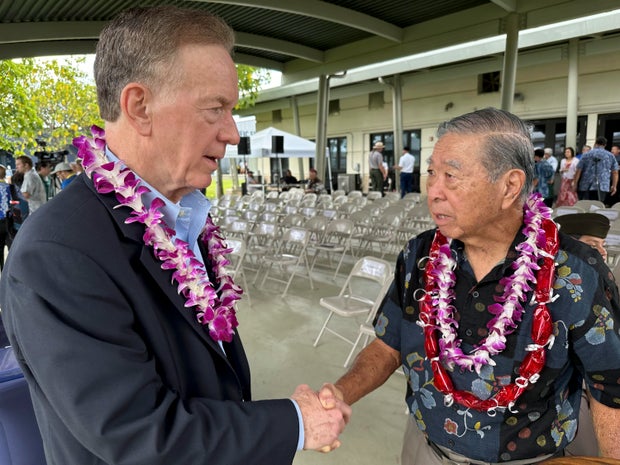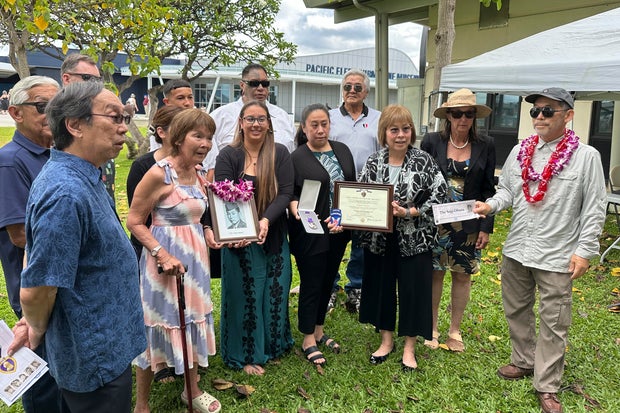Five Hawaiian men who served in a unit of Japanese-language linguists during World War II have been recognized with posthumous Purple Heart medals nearly 80 years after their plane crashed in the final days of the conflict.
The men – Joseph Kuwada, Haruyuki Ikemoto, Kazuyoshi Inouye, Wilfred Motokane and Masaru Sogi – were among 31 killed when their C-46 transport plane struck a cliff while trying to land in Okinawa, Japan, on August 13, 1945. Records of the Army indicate only two of the 31 Purple Heart medals received, which are awarded to soldiers wounded or killed during action against an enemy.
Audrey McAvoy/AP
O purple heart It is the country’s oldest military medal, dating back to the time of George Washington. It has been awarded almost two million times.
Researchers in Hawaii and Minnesota recently discovered the omission, leading the Army to agree to award medals to the families of the 29 men who were never recognized. Researchers have located the families of the five in Hawaii, and now the Army is asking the family of the five another 24 men contact them so your loved ones can finally receive recognition.
“I have no words. I’m just overwhelmed,” said an emotional Wilfred Ikemoto as he spoke about the belated honor given to his older brother, Haruyuki, during a ceremony in Pearl Harbor, Hawaii, on Friday.
“I’m very happy that he was recognized,” Ikemoto said.
The elder Ikemoto was the fourth of 10 children and the first in his family to attend college when he enrolled at the University of Hawaii. He was a photographer and developed films in a makeshift darkroom in a room in his house.
“I remember him as probably the smartest and most talented in our family,” said Wilfred Ikemoto, who was 10 when his brother died.
Aboard the plane were 12 paratroopers from the 11th Airborne Division, five soldiers from a Counterintelligence Detachment assigned to the paratroopers, 10 Japanese-American linguists from the Military Intelligence Service, and four crew members.
They all came from the Philippines to lead the occupation of Japan after the surrender of Tokyo, said Daniel Matthews, who analyzed the ill-fated flight while researching his father’s postwar service in the 11th Airborne Division.
Audrey McAvoy/AP
Matthews attributed the Army’s failure to recognize all 31 soldiers with medals to administrative oversight in the final hours of the war. The US was preparing to invade Japan’s main islands, but formulated alternative plans after receiving indications that Japan was preparing to surrender. To complicate matters further, there were four different units on the plane.
Wilfred Motokane Jr. said he had mixed feelings after accepting his father’s medal.
“I’m really happy that we’re finally recognizing some people,” he said. “I think it took a long time for this to happen. That’s the only part I don’t feel so good about, so to speak.”
The five from Hawaii were part of the Military Intelligence Service, or MIS, a U.S. Army unit made up mostly of Japanese Americans that interrogated prisoners, translated intercepted messages and traveled behind enemy lines to gather information.
The five were inducted in January 1944 after the MIS, desperate to get more recruits, sent a team to Hawaii to find more linguists, said historian Mark Matsunaga.
In total, around 6,000 served in the Military Intelligence Service. But much of his work remained relatively unknown because it was classified until the 1970s.
During the US occupation of Japan, they played crucial roles as liaisons between American and Japanese officials and in overseeing regional governments.
Audrey McAvoy/AP
Retired Army Gen. Paul Nakasone, who recently stepped down as head of U.S. Cyber Command and the National Security Agency, presented the medals to families during the ceremony on the shores of Pearl Harbor. Nakasone’s Hawaiian-born father served in the MIS after the war, giving him a personal connection to the event.
“What these Military Intelligence Service soldiers brought to the occupation of Japan was an understanding of the culture that could lead the vanquished to work with the victor,” Nakasone said. “I am very proud of all the MIS soldiers, not only during combat, but also during the occupation.”
During his search, Matthews also located the niece of the senior officer aboard the plane, Capt. John H. Norton of Marion, South Carolina. She will soon receive the Purple Heart in honor of her uncle, a 1943 West Point graduate and who led the counterintelligence team attached to the 11th Airborne Division.
He hopes the ceremony in Hawaii and another in South Carolina will help other families pursue the Purple Hearts their loved ones earned through their service.


























